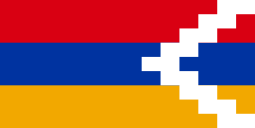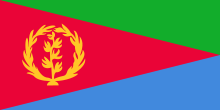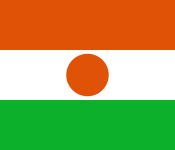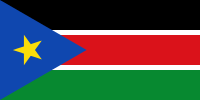MENA
MENA is an English-language acronym referring to the Middle East and North Africa, which corresponds to the Greater Middle East. It is alternatively called the WANA (Western Asia and North Africa), as well as the MENAP, which also includes South Asian countries of Afghanistan and Pakistan. The MENAP covers an extensive region stretching from the Maghreb in the west to Pakistan in the east. The MENA acronym is often used in academia, military planning, disaster relief, media planning as a broadcast region, and business writing.[1][2]
.svg.png)
List of countries
MENA has no standardized definition; different organizations define the region as consisting of different territories.
List of countries and territories most commonly constitute MENA.[1][3][4][5]
Additional countries and territories that are sometimes counted as part of MENA:

































*Non-sovereign territories.
Economy and education
The MENA region has vast reserves of petroleum and natural gas that make it a vital source of global economic stability. According to the Oil and Gas Journal (January 1, 2009), the MENA region has 60% of the world's oil reserves (810.98 billion barrels (128.936 km3)) and 45% of the world's natural gas reserves ( 2,868,886 billion cubic feet (81,237.8 km3) ).[6]
As of 2011, 8 of the 15 OPEC nations are within the MENA region.
According to Pew Research Center, 40% of the adult population in MENA has completed less than a year of primary school. The fraction is higher for women, of whom half have been to school for less than a year.[7]
Religion
Islam is by far the dominant religion in nearly all of the MENA territories; 91.2% of the population is Muslim. The Middle East-North Africa region comprises 20 countries and territories with an estimated Muslim population of 315 million or about 23% of the world's Muslim population.[8] The term "MENA" is often defined in part in relation to majority Muslim countries that based on the countries located in the region, although several nations in the region are not majority Muslim-dominated.[9]
Instability in the region
Due to rich resources, mainly oil and gas, combined with its location between three continents, (Asia, Africa and Europe), the MENA region has been in conflict since the collapse of the Ottoman Empire; notably due to the creation of Israel, a Jewish state among Arab and Muslim countries; Israeli–Palestinian conflict; the Iran–Iraq War; Iran–Saudi Arabia proxy conflict; and the rise of terrorism. Conflict in the region had come to its highest peak so far in the 21st century, with incidents such as the U.S. intervention of Iraq in 2003 and subsequent Iraq War and the rise of ISIS; the Arab Spring, which spread war to throughout the region such as the Syrian Civil War, Libyan Civil War and Yemeni Civil War.
Controversy over term
Due to the geographic ambiguity and Eurocentric nature of the term "Middle East", some people prefer use other terms like WANA (West Asia and North Africa)[10] or the less common NAWA (North Africa-West Asia).[11] MENA region remains the most common term and is used by most organizations, academia, and political entities flexibly, including those in the region itself.
Other terms
- MENAP
From April 2013, the International Monetary Fund started using a new analytical region called MENAP (Middle East, North Africa, Afghanistan, and Pakistan), which adds Afghanistan and Pakistan to MENA countries.[12] Now MENAP is a prominent economic grouping in IMF reports.[13][14]
- MENAT
The term MENAT (Middle East, North Africa, and Turkey) has been used to include Turkey in the list of MENA countries.[15][16]
See also
| Look up MENA in Wiktionary, the free dictionary. |
- Demographics of the Middle East and North Africa
- Fertile Crescent
- Near East
- Sahel
- Europe, the Middle East and Africa (EMEA)
- Gulf Cooperation Council (GCC)
- Middle East economic integration
- List of country groupings
References
- "World Bank Definition: MENA". Worldbank.org. Archived from the original on 29 October 2014. Retrieved 28 November 2014.
- "World Economic Forum on the Middle East and North Africa, Marrakech, Morocco, 26-28 October 2010". World Economic Forum on the Middle East and North Africa 2010 - World Economic Forum. Archived from the original on 10 April 2012. Retrieved 28 November 2014.
- Dumper, Michael, and Stanley, Bruce E., Cities of the Middle East and North Africa: A Historical Encyclopaedia, 2007
- George T. Abed, Hamid Reza Davoodi (2003). Challenges of Growth and Globalization in the Middle East and North Africa. International Monetary Fund. p. 2. Retrieved 10 February 2018.CS1 maint: uses authors parameter (link)
- "Cluster Munitions in the Middle East and North Africa" (PDF). Human Rights Watch. Retrieved 25 April 2018.
- "International Reserves". United States Department of Energy. Archived from the original on 13 May 2011. Retrieved 13 May 2011.
- Masci, David (11 January 2017). "About one-fifth of adults globally have no formal schooling". Pew Research Center. Retrieved 24 January 2019.
- "Middle East-North Africa Overview". Pew Forum. 7 October 2009. Archived from the original on 28 January 2017.
- "Politics and Islam in Central Asia and MENA". 24 April 2012. Archived from the original on 6 February 2017.
- "West Asia and North Africa: A Regional Vision". Worldbank.org. Archived from the original on 27 October 2014. Retrieved 28 November 2014.
- "Welcome". Agu.org. Archived from the original on 30 April 2005. Retrieved 28 November 2014.
- "World Economic Outlook Database". Imf.org. Archived from the original on 23 October 2014. Retrieved 28 November 2014.
- "World Economic Outlook Database" (PDF). Archived (PDF) from the original on 21 April 2016. Retrieved 23 April 2016.
- "MENAP" (PDF). Archived (PDF) from the original on 19 August 2014. Retrieved 3 October 2016.
- "MENAT Regional Council". Syracuse University Dubai. Archived from the original on 18 August 2016. Retrieved 14 June 2016.
- "About GE in the Middle East, North Africa and Turkey (MENAT)". General Electric. Archived from the original on 4 August 2016. Retrieved 14 June 2016.